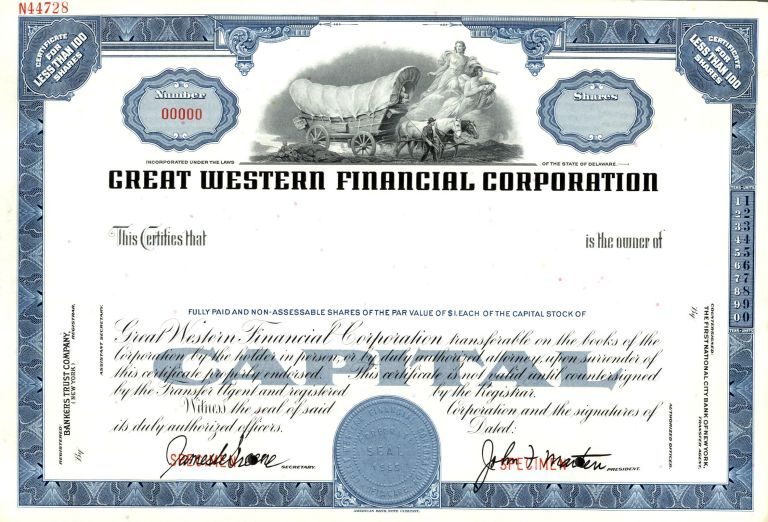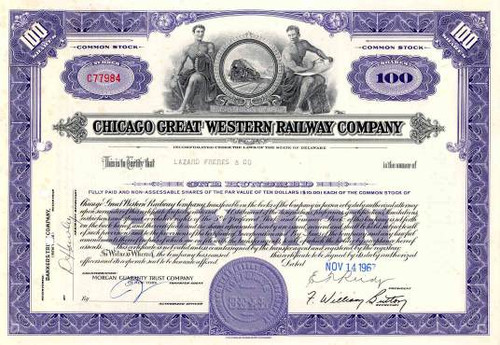Beautifully engraved specimen certificate from the Great Western Financial Corporation This historic document was printed by the American Banknote Company and has an ornate border around it with a vignette of a covered wagon and angelic figures. This item has the printed signatures of the Company's officers. 
Certificate Great Western Bank (previously known as Great Western Savings & Loan) was a large consumer bank that operated primarily in the Western United States. Great Western's headquarters were in Chatsworth, California. The bank was acquired by Washington Mutual in 1997 for $6.8 billion. Great Western Bank was held by Great Western Financial Corporation ("GWFC"), a corporation organized under the laws of the state of Delaware. Great Western was founded in 1919 in California as a Savings and Loan. In 1955, it was merged into a holding company, Great Western Financial Corp. Within five years, Great Western acquired Santa Ana Savings (1956), West Coast Savings (Sacramento, 1957), Guaranty Savings (San Jose, 1958), Central Savings (San Luis Obispo, 1959), and First Savings (Oakland, 1959). The company later bought Santa Rosa Savings (1968) and Safety Savings (Los Angeles, 1969). In 1970 and 1971, GW purchased four additional California S&Ls. In 1972, Great Western Financial combined them all into Great Western Savings. In October 1977, actor John Wayne filmed the first of several television commercials which he did over the next year for Great Western.[2] In August 1978, Wayne, in full western garb, filmed the most famous of his commercials for the bank in the Sequoia National Forest. A magnificent, full sized bronze statue of the actor still stands at 8484 Wilshire Boulevard in front of the bank's former Beverly Hills branch. Starting in 1982, and up until 1996, Great Western retained actor Dennis Weaver as its spokesman. The tagline of the bank's advertising campaign during this time was "We'll Always Be There". In late 1993, in the aftermath of the savings and loan crisis of the 1980s and 1990s, Great Western acquired 119 Southern California branches of the failed HomeFed Bank from the Resolution Trust Corporation. On January 17, 1994, GW's administrative campus in Chatsworth, California was particularly affected by the Northridge earthquake. Despite the quake, that year's profits quadrupled, thanks to the need for lower loss reserves and the gain on the sale of its 31 branches on Florida's Gulf Coast. In 1995, GW's chairman James Montgomery passed the office of CEO to president John Maher, who accelerated the drive toward banking services. In 1996, the company announced a $115 million restructuring program that would eliminate 800 jobs, consolidate mortgage banking branches, and install new technology. Later that year, GW sold its student loan business to Crestar Bank. In early 1997 California thrift H.F. Ahmanson & Co. launched a hostile takeover bid for the company, but Washington Mutual's friendly offer won out later that year. Ironically, in 1998 WaMu acquired Ahmanson for $10 billion. In Florida, during the 1980s and 90s Great Western Bank acquired all or part of the following institutions: Centrust, The First FA, Sunpoint Savings Bank, Carteret Federal Savings, Pioneer Savings Bank, Gibraltar Savings, Goldome, Amerifirst Federal, Chase Federal, City Federal Savings and Intercontinental bank of Jacksonville Beach The Forum, an arena in Inglewood, California, famous as the former home of the Los Angeles Lakers and Los Angeles Kings, was known as the "Great Western Forum" for several years. This name came from Great Western S&L, which paid for the naming rights on the arena in 1988. The name still remained for several years though Great Western ceased to exist. The 15-year naming rights contract expired in 2003, and the Great Western name was finally removed in 2006. Over ten years after the takeover, Great Western's logo was still visible in several places at their former headquarters in Northridge. History from Wikipedia, Encyberpedia and OldCompany.com (old stock certificate research service) About Specimen Certificates Specimen Certificates are actual certificates that have never been issued. They were usually kept by the printers in their permanent archives as their only example of a particular certificate. Sometimes you will see a hand stamp on the certificate that says "Do not remove from file". Specimens were also used to show prospective clients different types of certificate designs that were available. Specimen certificates are usually much scarcer than issued certificates. In fact, many times they are the only way to get a certificate for a particular company because the issued certificates were redeemed and destroyed. In a few instances, Specimen certificates were made for a company but were never used because a different design was chosen by the company. These certificates are normally stamped "Specimen" or they have small holes spelling the word specimen. Most of the time they don't have a serial number, or they have a serial number of 00000.

Certificate








